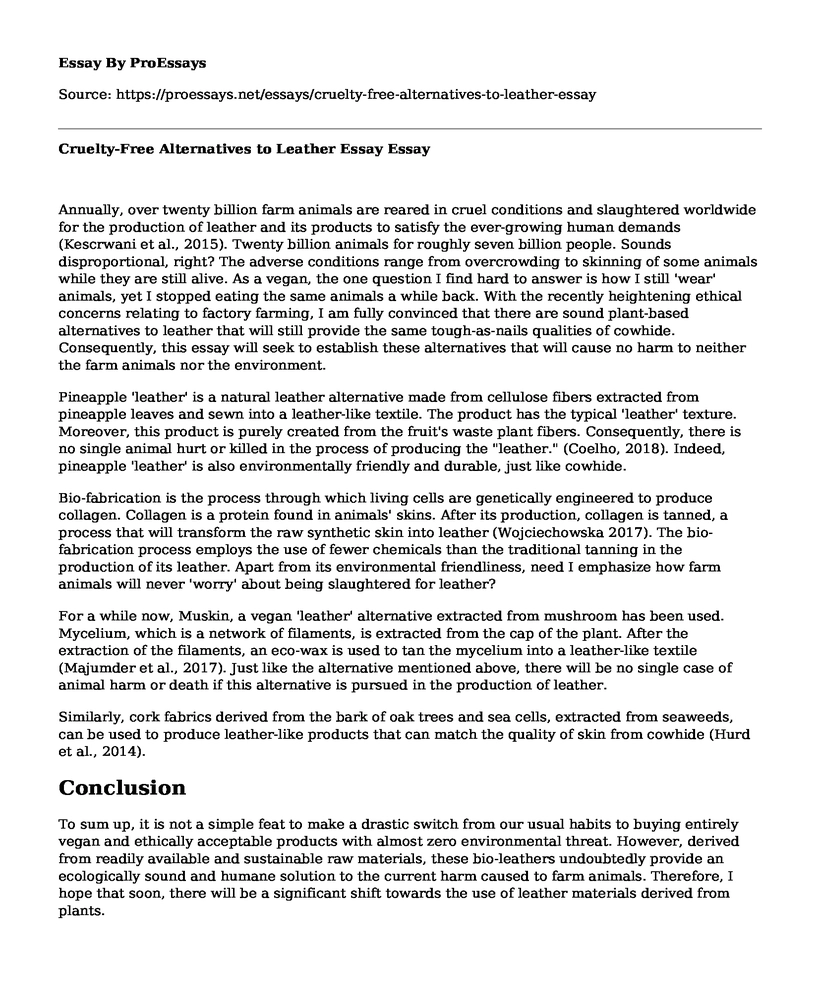Annually, over twenty billion farm animals are reared in cruel conditions and slaughtered worldwide for the production of leather and its products to satisfy the ever-growing human demands (Kescrwani et al., 2015). Twenty billion animals for roughly seven billion people. Sounds disproportional, right? The adverse conditions range from overcrowding to skinning of some animals while they are still alive. As a vegan, the one question I find hard to answer is how I still 'wear' animals, yet I stopped eating the same animals a while back. With the recently heightening ethical concerns relating to factory farming, I am fully convinced that there are sound plant-based alternatives to leather that will still provide the same tough-as-nails qualities of cowhide. Consequently, this essay will seek to establish these alternatives that will cause no harm to neither the farm animals nor the environment.
Pineapple 'leather' is a natural leather alternative made from cellulose fibers extracted from pineapple leaves and sewn into a leather-like textile. The product has the typical 'leather' texture. Moreover, this product is purely created from the fruit's waste plant fibers. Consequently, there is no single animal hurt or killed in the process of producing the "leather." (Coelho, 2018). Indeed, pineapple 'leather' is also environmentally friendly and durable, just like cowhide.
Bio-fabrication is the process through which living cells are genetically engineered to produce collagen. Collagen is a protein found in animals' skins. After its production, collagen is tanned, a process that will transform the raw synthetic skin into leather (Wojciechowska 2017). The bio-fabrication process employs the use of fewer chemicals than the traditional tanning in the production of its leather. Apart from its environmental friendliness, need I emphasize how farm animals will never 'worry' about being slaughtered for leather?
For a while now, Muskin, a vegan 'leather' alternative extracted from mushroom has been used. Mycelium, which is a network of filaments, is extracted from the cap of the plant. After the extraction of the filaments, an eco-wax is used to tan the mycelium into a leather-like textile (Majumder et al., 2017). Just like the alternative mentioned above, there will be no single case of animal harm or death if this alternative is pursued in the production of leather.
Similarly, cork fabrics derived from the bark of oak trees and sea cells, extracted from seaweeds, can be used to produce leather-like products that can match the quality of skin from cowhide (Hurd et al., 2014).Conclusion
To sum up, it is not a simple feat to make a drastic switch from our usual habits to buying entirely vegan and ethically acceptable products with almost zero environmental threat. However, derived from readily available and sustainable raw materials, these bio-leathers undoubtedly provide an ecologically sound and humane solution to the current harm caused to farm animals. Therefore, I hope that soon, there will be a significant shift towards the use of leather materials derived from plants.
References
Chua, J., & Chua, J. (2018). 7 Eco-Friendly (and Vegan!) Alternatives to Animal Leather. Inhabitat.com. Retrieved 19 March 2018, from https://inhabitat.com/ecouterre/7-eco-friendly-and-vegan-alternatives-to-animal-leather/
Coelho, J. (2018). FUTURE OF FAUX FASHION - Ethical and environmentally friendly alternatives - The Gibraltar Magazine. The Gibraltar Magazine. Retrieved 19 March 2018, from http://thegibraltarmagazine.com/future-faux-fashion-ethical-environmentally-friendly-alternatives/
Company Making Cruelty-Free Leather in a Lab to Debut First Product This October!. (2018). One Green Planet. Retrieved 19 March 2018, from https://www.onegreenplanet.org/?s=cruelty-free+alternatives+to+leather&submit=Search
Hurd, C. L., Harrison, P. J., Bischof, K., & Lobban, C. S. (2014). Seaweed ecology and physiology. Cambridge University Press.
Kesarwani, P., Jahan, S., & Kesarwani, K. (2015). A review on leather processing. International Journal of Applied Research, 1(9), 977-982.
Majumder, R., Banik, S. P., Ramrakhiani, L., & Khowala, S. (2015). Bioremediation by alkaline protease (AkP) from edible mushroom Termitomyces clypeatus: optimization approach based on statistical design and characterization for diverse applications. Journal of chemical technology and biotechnology, 90(10), 1886-1896.
Wojciechowska, I. (2017). The Leather Underground: Biofabrication Offers New Sources for Fabrics. AATCC Review, 17(6), 18-23.
Cite this page
Cruelty-Free Alternatives to Leather Essay. (2022, Apr 04). Retrieved from https://proessays.net/essays/cruelty-free-alternatives-to-leather-essay
If you are the original author of this essay and no longer wish to have it published on the ProEssays website, please click below to request its removal:
- Essay Example on Violence in the Media
- The Immigrant Artist at Work: Artists in Haiti Paper Example
- Essay Sample on Financial Education: A Key to Lowering Global Poverty Rate
- Paper Example on Substance Abuse: A Global Crisis, A Personal Tragedy
- Mexico's War on Drugs: Violation of Women's Human Rights - Essay Sample
- Essay Example on Urban Poverty, Crime & Wilson's Theory: Racial Dynamics at Play
- Essay Example on Rising Poverty in Seoul: Impact of 21st Century Economic Crisis







